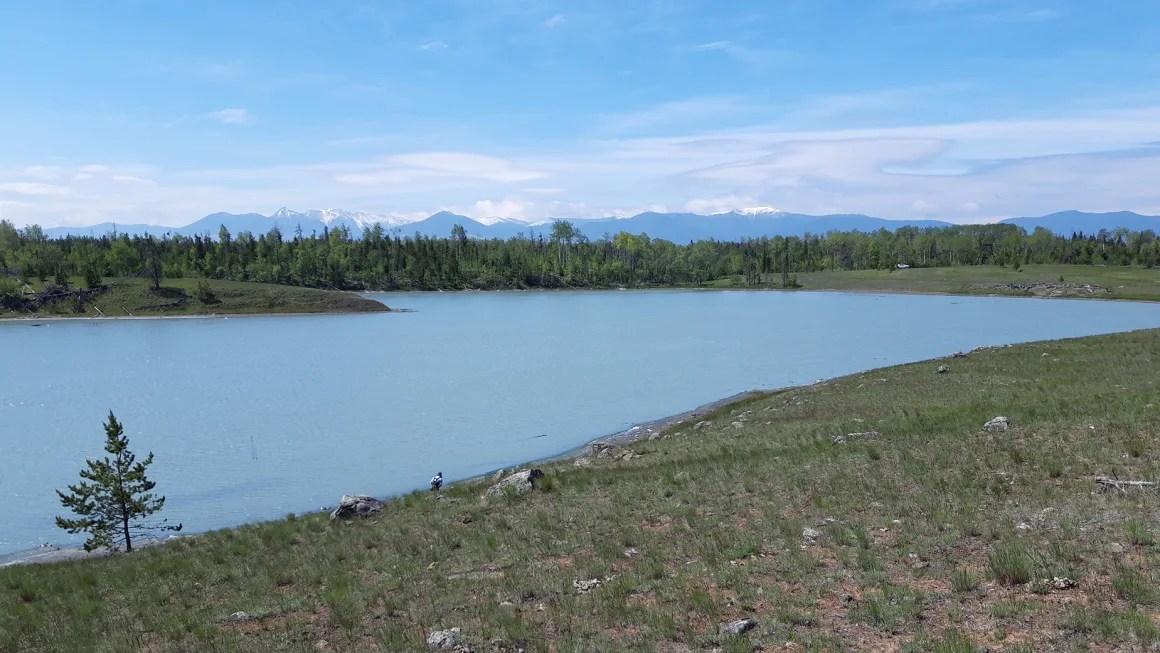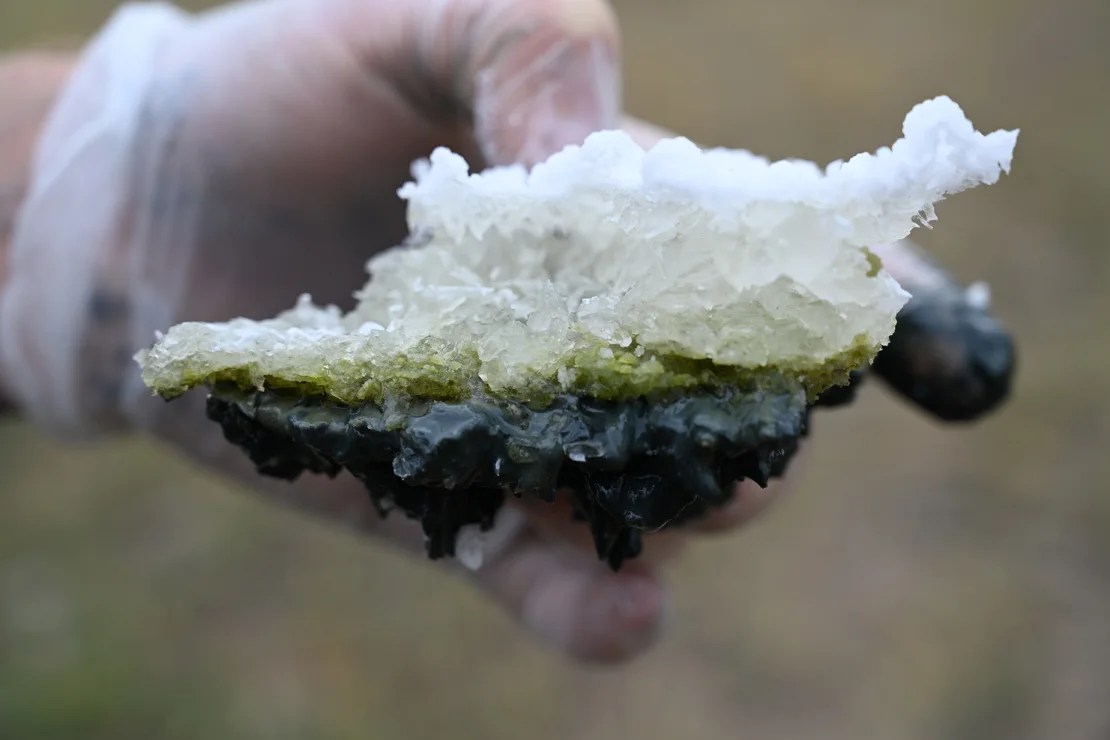(CNN) — Imagine a completely sterile world. In front of you is a volcanic landscape devoid of plants and animals. Scattered across this gray and black expanse are shallow bodies of water. In each of these natural ponds, a precise combination of chemicals and physical conditions is created that can serve as a source of life on our planet.
Some scientists have hypothesized that the landscape may have looked more like this, rather than an oceanic one, when life first appeared on Earth about 4 billion years ago, and a study focused on a modern lake in the Canadian province of British Columbia. provides new support for this idea.
The shallow, salty body of water above volcanic rock, known as the Last Chance Lake, contains evidence suggesting that carbonate-rich lakes on ancient Earth could have been the “cradle of life,” according to study co-author David Catling. At the University of Washington. These findings, published in the journal Nature on January 9, could advance scientific understanding of the topic How life began.
“We were able to look for the specific conditions that people use to assemble the building blocks of life in nature,” Catling said. “We think we have a very promising place for the origin of life.”

Last Chance Lake in British Columbia, photographed here during the rainy season in June 2022, contains the highest levels of concentrated phosphate ever recorded in any natural body of water on Earth. (David C Catling)
Catling and his colleagues first realized the lake was a place to focus their research after a literature review revealed an unpublished master's thesis from the 1990s, which recorded unusually high levels of phosphate there. But the researchers had to see for themselves.
Last Chance Lake
Last Chance Lake is no more than 30 cm deep. Located on a volcanic plateau in British Columbia more than 1,000 meters (3,280 feet) above sea level, it has the highest levels of phosphate concentration ever recorded in any natural body of water on Earth.

Haas shows a piece of dry-season lake crust taken from Last Chance Lake in September 2022. Researchers used the lake as a “representative environment” to understand soda lakes on early Earth. (David C Catling)
Phosphate is an important element in biological molecules. It is a chemical compound that contains phosphorus, the element that sustains life. It is found in molecules such as RNA and DNA, as well as ATP, a molecule essential for energy production in all forms of life. The abundance of phosphate in Last Chance Lake is more than 1,000 times greater than that found in oceans or lakes, according to Sebastian Haas, a postdoctoral researcher who studies the microbiology and chemistry of aquatic environments at the University of Washington, who led the research. .
Between 2021 and 2022, the research team visited Last Chance Lake to collect and analyze water and sediment samples.
That's when they discovered that Last Chance Lake is not only a hotbed of phosphate, but also of the mineral dolomite, which allows phosphorus to accumulate in this environment and forms in response to the reaction in the lake between calcium, magnesium, and carbonate. Combined chemical processes, influenced by minerals in the volcanic rock on which the lake formed, combined with an arid climate, effectively produced unique concentrations of phosphate, a set of conditions that researchers believe may have once given rise to life on Earth. According to Haas.
“We add credibility to the idea that this type of environment would be suitable for the emergence of life, which is plausible,” he said.
Last Chance Lake is not only 4 billion years old, in fact it is estimated to be less than 10,000 years old. The site is simply a modern analogy, or a natural snapshot of the past that ultimately provides scientists the opportunity to better understand what the primordial Earth was like outside the laboratory.
“There is every reason to believe that similar lakes existed on the early Earth about 4 billion years ago, because the volcanic rocks on which Last Chance Lake rests are essentially a prerequisite for the formation of soda lakes,” Haas said. “And what we're partly showing here is that the chemistry of the soda lake water is the prerequisite for these high phosphate levels.”
Darwin's warm little pools
“Soda lakes,” like Last Chance Lake, are shallow bodies of water filled with dissolved sodium and carbonates, much like baking soda, that typically come from interactions between water and volcanic rock. They can be found all over the world, but are much less common than other bodies of salt water.
“These types of lakes have the highest levels of phosphate that match what people use in the lab to make (genetic molecules),” Catling said.
When scientists tried in the laboratory to replicate the chemical reactions that make biomolecules essential to the origin of life, the phosphate concentrations required were up to a million times higher than those typically found in the world's natural bodies of water.
“If you had these types of lakes on ancient land, they would have a very high phosphate content, just like Last Chance Lake,” Catling added.
Bodies of water like these have long been on scientists' radar as potential sources of primitive life. In the 19th century, Charles Darwin first wrote about his “little warm pond” theory, which proposed that warm, shallow, phosphate-rich lakes could be where the first molecules of life formed.
“Part of what (Darwin) envisioned were these effervescent pools… like Yellowstone,” said Matthew Pasek, a professor at the University of South Florida who studies the chemistry of phosphorus and the origins of biological sciences.
But this is not the only popular theory about how life first appeared on Earth billions of years ago. The other reason is that life began in deep-sea hydrothermal vents.
The new study adds to the body of evidence supporting the warm little pond hypothesis, according to Pasek, who was not involved in the research.
“The main point, which is that you can get such high concentrations of phosphate in these ponds, is certainly reinforced by this result,” he said. “It shows that this is how it can happen.”
However, phosphate in large quantities is not the only substance necessary for the emergence of life. The list of basic requirements also includes sources of carbon and nitrogen, as well as appropriate chemical and physical elements (including phenomena known as wet-dry cycles) that allow the formation of the necessary chemical compounds and reactions.
But the authors said they are not arguing that the Last Chance Lake that exists today contains all the ingredients necessary for the building blocks of life, but rather that it contains only some of the essential pieces.
“The current Lake of Last Chance does not contain many of the chemicals that we now think were likely crucial to the origin of life,” Haas said, citing cyanide as an example. Previous studies suggest that a primitive version of a soda lake may have contained this substance.
While this work “does not uniquely resolve the question of where life originated,” according to Woodward Fisher, a geobiologist at Caltech who was not involved in the study, “it does shed light on existing environments on Earth that “scientists can study.” “…in more detail to better understand the mechanisms responsible for creating life on our planet and perhaps elsewhere.”
The origin of life on Earth and beyond
If life actually arose in soda lakes on Earth, rather than at the bottom of the ocean, this knowledge could, in theory, help in the search for evidence of extraterrestrial life.
“If you think life originated at the bottom of the ocean, you can get a closer look at the subglacial ocean on the moons of Saturn and Jupiter,” Haas said. “But if you think life arose on Earth, then planets like Mars could be much more important.”
The same type of rock formations that produce soda lakes can be found on much of the surface of rocky planets like Mars, suggesting that life may have formed similarly elsewhere in the universe.
“Understanding how life arose on Earth is of such importance to our search for life beyond Earth,” Haas told CNN. “Better understanding how life arose on Earth allows us to search for life on other planets, or moons of other planets, in the solar system.”
Aurilla Horn-Müller writes for Axios and Climate Central. His book, “Devouring: The Extraordinary Story of Kudzu, the Vine That Ate the South,” is scheduled to be published in the spring.

“Proud web fanatic. Subtly charming twitter geek. Reader. Internet trailblazer. Music buff.”

:quality(85)/cloudfront-us-east-1.images.arcpublishing.com/infobae/TEQF6EONZRFGLLLDIDD4L2O4EE.jpg)

:quality(75)/cloudfront-us-east-1.images.arcpublishing.com/elcomercio/XU32LRAEZFDDPNVHLFU3CKVBYY.jpg)


More Stories
How to create 3D videos with my iPhone, it will be very useful even for your business
NASA discovers an anomaly in the Earth’s magnetic field that could have serious consequences for humans
Can the Earth be divided into two parts?